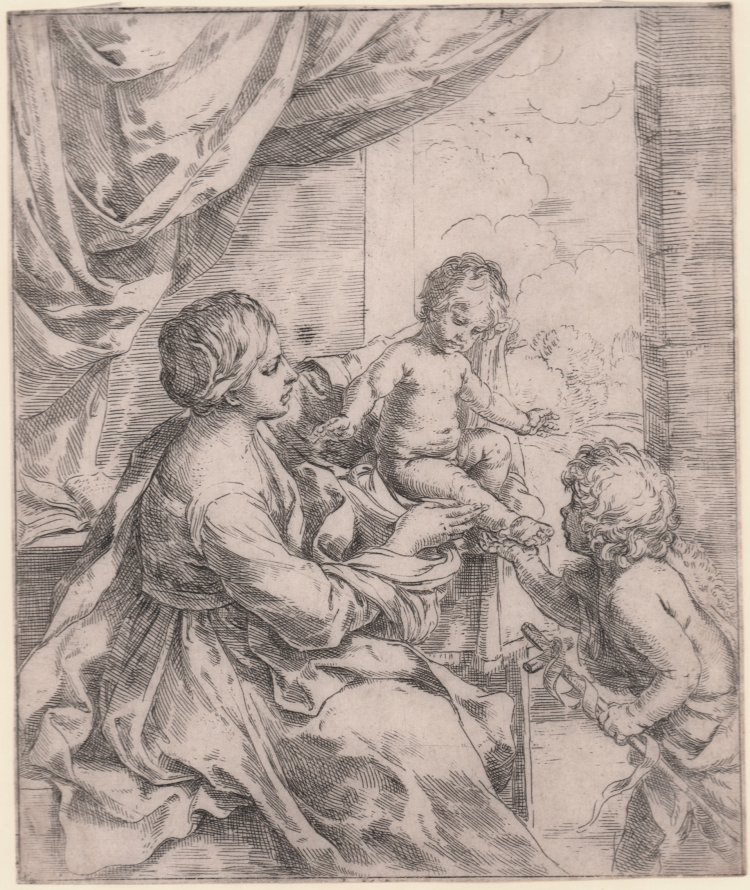




| Reference: | S17254 |
| Author | Guido RENI |
| Year: | 1630 ca. |
| Measures: | 156 x 188 mm |



| Reference: | S17254 |
| Author | Guido RENI |
| Year: | 1630 ca. |
| Measures: | 156 x 188 mm |
Etching, 1620/30 circa, unlettered.
Bartsch identifies a single state and mentions the rarity of the sheet. In fact, sixteen examples of this etching have been located, which contradicts Bartsch's statement.
According with Veronica Birke, for the light of the three-dimensional and spatial quality of the composition, this etching probably dates from the end of the 1620s or the beginnings of the 1630s.
A drawing in Windsor Castle (RL 3247) emphasizes the painterly character of this representation.
Guido Reni (Calvenzano 1575 - Bologna 1642) devoted himself to etching at an early age. The artist's earliest graphic works closely follow Parmigianino's works; moreover, Reni copied the Parmigianino’s plates depicting the Deposition and the Arms of the Sforza family. This influence will remain evident throughout his production, even later, particularly in the sweetness of certain Madonnas with Child and Holy Families. It is important to mention the work done by the young Guido Reni in 1603 for the funeral ceremonies in honour of Agostino Carracci in Bologna, which echo in style, dry and essential, the series of engravings made by Reni himself for the entrance of Pope Clement VIII Aldobrandini in Bologna in 1589. His graphic activity remained on the sidelines of his larger pictorial production and almost exclusively concerned religious subjects.
Bibliografia
Bartsch / Le Peintre graveur (XVIII.282.6); Veronica Birke in The Illustrated Bartsch (4005.034); Le Blanc 6.
Guido RENI (Calvenzano 1575 - Bologna 1642)
|
A famous painter, he was nearly deified by French and English artistic literature of XVIII and XIX centuries. His first graphic works kept strict to Parmigianino’s art. Moreover, in Rome he copied the painter’s plates depicting the Deposizione and the Armi della famiglia Sforza. Parmigianino’s influence can be found all along his artistic life, especially in the gentleness of his Madonne col Bambino and the Sacre Famiglie.
It is also important to remind the contribution young Guido gave in 1603 for the realization of the funeral service of Agostino Carracci in Bologna, which has the same style of the series of engravings Reni realized when Pope Clemente VIII of the Aldobrandini’s family entered in Bologna.
His graphic acrtivity played a smaller role in his pictorial production and was mainly about religious subjects. He was in fact convinced that he could intensify and widespread the religious and emotional aspects of the Counter-Reformation in his works.
|
Guido RENI (Calvenzano 1575 - Bologna 1642)
|
A famous painter, he was nearly deified by French and English artistic literature of XVIII and XIX centuries. His first graphic works kept strict to Parmigianino’s art. Moreover, in Rome he copied the painter’s plates depicting the Deposizione and the Armi della famiglia Sforza. Parmigianino’s influence can be found all along his artistic life, especially in the gentleness of his Madonne col Bambino and the Sacre Famiglie.
It is also important to remind the contribution young Guido gave in 1603 for the realization of the funeral service of Agostino Carracci in Bologna, which has the same style of the series of engravings Reni realized when Pope Clemente VIII of the Aldobrandini’s family entered in Bologna.
His graphic acrtivity played a smaller role in his pictorial production and was mainly about religious subjects. He was in fact convinced that he could intensify and widespread the religious and emotional aspects of the Counter-Reformation in his works.
|